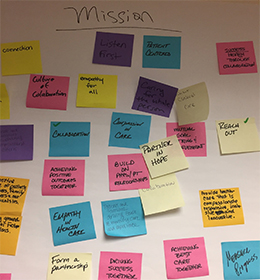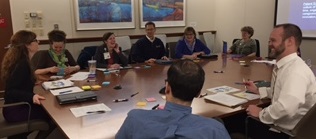
Editor’s Note: Cleveland Clinic’s Our Voice Healthcare Partners Council was recognized as a finalist for the 2018 Sherman Award for Excellence in Patient Engagement. The Sherman Award is co-sponsored by Taylor Healthcare and the IHI/NPSF Lucian Leape Institute. In addition to selecting Sherman Award winners each year, the judges name finalists when the caliber of their projects warrant special recognition. Winners and finalists were announced at the IHI/NPSF Patient Safety Congress held in Boston, Massachusetts, in May.
“Patients First” has been the guiding principle of Cleveland Clinic for nearly 100 years. As home to over 50,000 employees and more than 6 million annual patient visits, our ability to deliver innovative, efficient and collaborative design and care is essential. We can only accomplish that through collaboration with healthcare partners – our patients, their family members and supportive friends – actively engaged in co-designing programs, processes and facilities that support clinical care.
In this project, a diverse team of patients, support people and Cleveland Clinic employees came together to reimagine and co-design how to improve healthcare, support a vision of Patients First and provide relationship-centered care. The result, the Our Voice Healthcare Partners Council, is a robust program with multiple avenues for partnering to improve care, with a mission to collaborate on principles of co-leadership, co-design, proactive contribution, committee work, transparency and community.
Why re-imagine partnership?
For many years, patient advisors have informed care at Cleveland Clinic through committees across the enterprise, actively providing feedback, with tremendous impact. With the changing healthcare landscape, the Office of Patient Experience became aware of the need to be even more intentional in our partnership, as complex problems can only be solved in collaboration, with deep appreciation for the needs and values of all stakeholders.
Several opportunities to co-design a new partnership were identified:
- Healthcare partners were often brought into the conversation after much design effort had concluded; we desired a real-time collaboration and co-design.
- Ability to connect across councils and share learnings.
- Feedback and follow-up on projects.
- Remote participation and research opportunities. This became the catalyst for reimaging how we partner. The result was a program in which all aspects were co-designed in an effort to elevate this partnership across the enterprise.
Healthcare partners and employees co-designing to improve care
Healthcare partners and employees were invited to re-imagine how we partner to improve care. In healthcare, users often serve in more than one role – patients, support people, family members and employees; design and partnership may occur at the intersection of these roles. This was the rationale behind bringing together healthcare partners and employees to co-design partnership. We formed a team consisting of healthcare partners, council leads and employees of the Office of Patient Experience and engaged in several strategies to co-design healthcare partnership.
Co-creation sessions using participatory design methods were utilized to capture core needs and dream up what might be possible. Surveys and data analysis were utilized to engage additional healthcare partners in the design process. Interviews were conducted with patients and council facilitators to highlight strengths and opportunities, as well as desires, moving forward. The team then synthesized this data into the co-designed program. All aspects of the program, from the name – Our Voice Healthcare Partners Council – to guiding principles for this work moving forward, to recruitment, onboarding and governance were co-designed. Our healthcare partners challenged us to move from advocate or advisor to partner, working side-by-side to collaboratively improve care.
No longer “going it alone”
The Our Voice Healthcare Partners Council is a robust program with multiple avenues for partnering to improve care including traditional meetings, continuous improvement projects, human-centered design, specialty focus areas, enterprise committee work and remote response or research. A standard approach to recruitment, onboarding and a database that can be leveraged to share work transparently across the enterprise were built to support our desire to honor contribution by sharing how projects changed as a result of input. In designing a program that our healthcare partners co-created, we saw tremendous growth and impact.
Including all healthcare partners is essential to navigating the changing healthcare landscape. We believe that healthcare partners should be represented in the work that we do and that designing together with our patients, support persons and employees will get us to a better place. Going it alone is not an option.
We set out with aspirations to change and improve our healthcare partners’ experience and found ourselves changed in the process.




